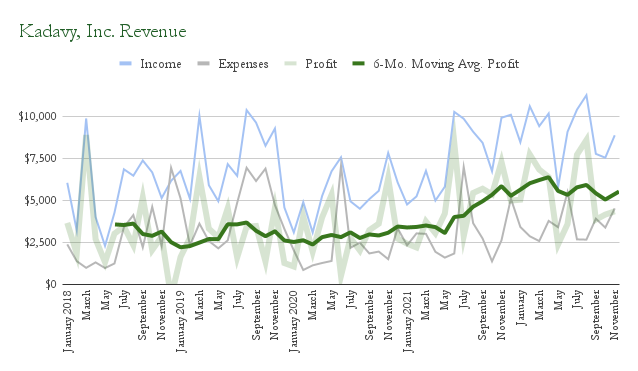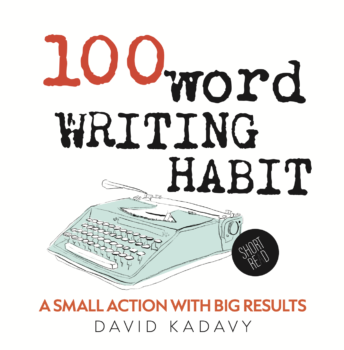Subscribe to blog updates via email »
November 2022 Income Report
An audio version of this income report is available to Patreon backers of certain levels »
November’s income was $8,903, up from October’s $7,564. Profits were $4,364, up from October’s $4,171.


WANT TO WRITE A BOOK?
Download your FREE copy of How to Write a Book »
(for a limited time)
14-month streak of book income records
This is the fourteenth month in a row I’ve had record yearly book income. My income from self-published books over the previous twelve months was $85,863.
Record yearly book profits
This month, I also broke my record for yearly book profits – albeit not a streak. I’ve made $54,195 profit in the previous twelve months, on self-published books. Naturally, my monthly book profits are a record, too, at $4,516.
New short read coming soon!
This month, I spent $1,452 on Outside Contractors. This is for my upcoming short read, 100-Word Writing Habit. This one is based upon my email course by the same name, which has been pretty successful. I decided this time around to hire help for design and layout. Here’s a sneak preview.


Besides experimenting with hiring a designer, I’m also experimenting with a couple other things. One is releasing only a paperback version. The other is developing a book specifically intended to be shared on Instagram. I used IngramSpark’s new custom trim sizes to develop this book in a perfectly-square format, with lots of great quotes (“The medium is the message”).
As soon as the design is finalized, I’ll order a proof. I hope to launch this one no later than the beginning of February.
Black Friday sale brought in course revenue
I ran a promotion on my courses for Black Friday, and brought in some extra revenue. The $3,263 I made on Digital Products is the most I’ve made since last November, when my Black Friday sale brought in $4,048.
Obviously, that’s less. I’m not worried about it, as I haven’t introduced a new course in a while, and many readers who have been with me for years have probably already bought all of them.
Trying YouTube versions of podcast essays
Armed with my new camera and lens, I’ll be experimenting with YouTube versions of podcast essays for January’s episodes. The January episodes have in fact already been uploaded to YouTube and scheduled.
I’ve held off on doing video for a long time, because deciding to do so is one decision that leads to a thousand other decisions. For now, I’ve punted on most of those other decisions. I haven’t decided what to do about intro music or an intro animation, or closing announcements such as podcast interviews of me or Patreon supporters. For now, I’ve just left those things out.
I also got stuck on how to integrate my video post-production process with my audio post-production process. For now, I’ve simply done the video post-production myself, and my audio post-production is going through its normal process.
How will I know if it’s “worth” making video essays?
Though I’m happy with my camera and lighting quality, I know the video versions of my essays are far from ideal for YouTube. They’re just me talking to the camera (aside from, in one, a little Apple Motion magic to bring to life an audio clip from a former guest). I’m not even going to bother with custom thumbnails for now.
Again, it’s an experiment. As such, I should make a prediction about it. How will I decide if this is successful and worth doing, or not? Since I still don’t know exactly how much work is involved in making these, which will affect whether or not I decide to keep making video episodes – and I refuse to limit myself to a metric such as “time spent producing these” – I’m more interested in defining a bar for success under which I will stop making video essays, and return to the audio-only format.
How long an experiment?
My latest five YouTube essay episodes – audio-only with static images – have averaged a dismal 37 views. I think if I don’t average more than that for my January episodes by the end of February, I shouldn’t bother doing video essays for now. That essentially commits me to a three-month experiment, as by the end of February, I’ll be producing my episodes for March.
What results do I expect?
How confident am I that I will average more than 37 views for my two January episodes, by the end of February? 70% confident, which is to say, not terribly confident. Even the hour-long interview with David Perell I have on YouTube has only 159 views. My most successful essay episode is my summary of the Unabomber manifesto, which, after seven months, has “only” 4.7k views (This episode was on the “sure bet” side of my barbell, without much competition for search traffic).
This isn’t the “right way,” but what is?
This brings up the question, is it worth publishing to a medium if you aren’t going to do it well? A big mistake I see creators make is feeling they need to get their work onto all channels, without taking the time and care to think about how it should be adapted to that channel – or whether they should bother at all. Nobody is going to click on the Twitter link you’ve automatically syndicated to your feed, and apparently few will listen to the podcast episode you’ve syndicated to YouTube with a static image.
To “properly” syndicate podcast essays to YouTube, I “should” accompany them with detailed animations and b-roll to go along with the essay. I also “shouldn’t” include the episode number in the title, which I do right now. I “should” also have intro and outro animations and music, and a custom thumbnail for each episode. When you’re currently averaging 37 views per episode, it’s hard to get excited about doing that extra work.
The problem of nonlinear results
But, I suspect an investment in trying to do YouTube properly would result in concave, rather than linear growth. That is to say, each improvement by one “unit” probably brings results greater than that “unit.” However, that’s averaging out over the entire quality scale. In other words, there may be no improvement in results until you reach a certain threshold, at which point there may be exponentially-better results.
Doing some YouTube “right”
Now, syndicating adapted podcast essays to YouTube isn’t “properly” doing YouTube at all. The “proper” way to do YouTube is to create content specifically for YouTube. I do hope to do a bit of that in 2023, specifically updating my ActiveCampaign Review, which has been instrumental helping me earn over $75,000 as an affiliate over recent years.
Should I syndicate the podcast to YouTube at all?
So the obvious question is, if my talking-head podcast essays don’t bring more views, should I bother syndicating the podcast to YouTube at all? The static-image episodes require very little effort (aside from making the thumbnail with a template), a handful of people get utility from them (some people use YouTube just to listen), and some episodes do well despite having no video content, which increases my reach. So this question is more about whether syndicating to YouTube costs me anything, in terms of reduced YouTube performance – if I care about that. I don’t know whether it harms the performance of my other videos, but I don’t think I care enough about YouTube at this point to surrender what benefit comes to myself and/or the small number of viewers to change my strategy either way.
Intangibles
Even if my talking-head podcast essays don’t bring in more views, I could argue that they’re worth it, anyway. There’s a stronger connection made with viewers who can see my face, and even if those viewers are small in number, there are a couple other benefits I get from being on video often: One is that it signals to podcast hosts that I have the proper setup to make a high-quality video appearance on their podcast. The other is that it gives me a chance to practice the nuances of reading a script on-camera. Now that I’ve recorded so many essays, I’m not as excited about the challenge of delivering a solid voiceover performance as I once was. Adding video into the mix brings that excitement back, and may improve my voiceover performance, as well as make the process more enjoyable.
Contaminating the experiment
I’m still not sure to what extent I should or shouldn’t “put my thumb on the scale” in this experiment. To isolate the impact of video in my essays, I should publish them without notifying anyone of the difference. Then again, how can you know the potential, without giving it the fanfare it deserves? “My podcast essays are available on YouTube with a static image,” is not worth mentioning. “My podcast essays are now available with video on YouTube,” is. However, there would likely be an initial jump in views upon announcing such a thing, then views would regress toward the norm. In any case, here I am talking about it in my income report, contaminating my experiment.
Growing during the experiment
As I prepare videos such as these, as well as reels for TikTok, Instagram, Facebook, and YouTube Shorts, it’s possible my video-editing skills will get good enough I can add enough pizzaz to my YouTube essays to make them perform well. Or, maybe I’ll find video editors I like working with and take on the extra expense of making the videos better.
I do know that I’m curious to see what happens as I do more video. Even by producing reels, I’m noticing some qualitative signals that suggest they’re being well-received (messages and comments specifically saying so, old friends getting back in touch, and an increase in search traffic specifically for my name). They’re fun to make, and they translate easily across a variety of platforms.
The Heart to Start as a Kindle Big Deal
The Heart to Start was chosen by Amazon as a Kindle “Big Deal.” And I will now go on record as saying that I regret agreeing to this promotion.
I’ve enjoyed my Kindle Daily and Kindle Monthly Deals in the past. They cost me nothing, and bring in extra revenue. But this Kindle “Big Deal” crossed a line for me.
Amazon decided to mark HTS down to 99¢, which is the lowest price it’s been in five years. I wouldn’t have marked it so low, myself. But, if Amazon was going to promote it, I figured it would be worth it. I even wondered to myself if I might have a shot at the WSJ list with a price like that, and Amazon’s help – if I also had a BookBub Featured Deal.
BookBub didn’t accept HTS for a deal. That’s okay, and I didn’t have flexible dates nor much notice to give them, anyway. But, I still figured with Amazon’s help, I might sell a thousand copies or so.
Amazon didn’t hold up their end of the bargain
But from what I could find, Amazon did nothing to promote this so-called “Big Deal.” I ended up sending an email to my lists, and that was the only thing that led to a spike in sales. Navigating through Amazon’s Kindle Deals listings, HTS was not listed in any of the book categories in which it should have been. I contacted Amazon, and got a generic customer service representative who said a technical team would look into it, and it would take some time. Well, this “Big Deal” was only scheduled to be about five days, so even if there was a technical issue, there wasn’t time for someone to help straighten it out.
The “Big Deal” is anything but
So, my recommendation is that if Amazon offers you a Kindle “Big Deal,” and you have reservations about the price, don’t accept it. In my experience, they did nothing to promote it. My book was priced at the lowest price in five years, and I got only a handful of sales more, mostly from promoting to my own audience, and almost certainly by no help of an email blast or even a listing as a Kindle Deal by Amazon. In the process, my book is now ineligible for a BookBub Featured Deal for at least 30 days, and now I have a 99¢ price in my recent history.
Looking through my email chain, I’m not sure I had the option to refuse the deal once I knew the terms. Amazon sends a vague invitation several months out, which you can accept or reject, and in the case of this deal, sent another message about a month in advance informing me of the dates and price of the deal. Had I known the Kindle “Big” Deal was anything but, I would have at least requested they cancel the promotion. I feel like I was played by Amazon on this one.
End-of-year giving
I’ve had a good year, so I had some extra money to donate before the end of the year. I made donations to a couple free tools I use frequently: Wikipedia, and Archive.org. I also made a donation to GiveWell. They’re an Effective Altruism organization that stays on top of what charities make the highest-impact use of donor money, and distribute accordingly.
$333 from Treehouse
Apparently there was a tax document I needed to fill out with Treehouse. I don’t think I’ve referred anyone to them for a long time, but I had a balance of $333 owed to me, which I received this month.
Thank you for having me on your podcasts!
Thank you for having me on your podcasts! Thank you to Brilliant Miller at The School of Good Living, and Paul Millerd at The Pathless Path.
Income
Book Sales
| Mind Management, Not Time Management Kindle | $803 |
| Mind Management, Not Time Management Paperback (Amazon) | $1,125 |
| Mind Management, Not Time Management (non-Amazon) | $888 |
| Mind Management, Not Time Management Audiobook | $743 |
| Digital Zettelkasten Kindle | $524 |
| Digital Zettelkasten Wide (non-Kindle) | $149 |
| Digital Zettelkasten Audiobook | $67 |
| The Heart to Start Kindle | $224 |
| The Heart to Start Paperback (Amazon) | $68 |
| The Heart to Start “Wide” (non-Amazon) | $58 |
| The Heart to Start Audiobook | $27 |
| How to Write a Book Kindle | $51 |
| How to Write a Book Paperback | $98 |
| How to Write a Book “Wide” (non-Amazon) | $0 |
| How to Write a Book Audiobook | $58 |
| How to Write a Book Spanish (all) | $9 |
| Make Money Writing on the STEEM Blockchain (all) | $6 |
| Ten Passive Income Ideas | $5 |
| Total Book Sales | $4,904 |
Digital Products
| Blog 2 BLING! | $1,495 |
| D4H Video | $832 |
| Explosive Email Course | $79 |
| Motivational Judo | $614 |
| Summer of Design | $9 |
| White Hot Course | $235 |
| Total Digital Products | $3,263 |
Affiliates / Advertising
| Active Campaign | $0 |
| Alliance of Independent Authors | $0 |
| Amazon | $92 |
| Hostgator | $100 |
| SendOwl | $0 |
| Treehouse | $333 |
| Total Affiliates | $525 |
Love Your Work Podcast
| Patreon | $211 |
| Total LYW Podcast | $211 |
Services
| Clarity | $0 |
| Medium | $0 |
| Total Services | $0 |
| GROSS INCOME | $8,903 |
Expenses
General
| Accounting | $656 |
| Outside Contractors | $1,452 |
| Podcast Editing / Publishing | $123 |
| Quickbooks | $45 |
| Total General | $2,276 |
Advertising
| Amazon | $1,860 |
| Total Advertising | $1,860 |
Hosting
| ActiveCampaign | $135 |
| Bookfunnel | $15 |
| Drafts | $2 |
| Dropbox | $10 |
| Fathom Analtyics | $14 |
| Libsyn | $7 |
| Namecheap | $30 |
| SendOwl | $9 |
| Teachable | $39 |
| Typeform | $26 |
| Ulysses | $7 |
| WP Engine | $96 |
| Zapier | $14 |
| Total Hosting | $403 |
| TOTAL EXPENSES | $4,539 |
| NET PROFIT | $4,364 |



